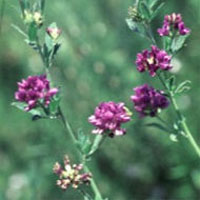Alfalfa
 © Steven Foster
© Steven FosterParts Used & Where Grown
Alfalfa, also known as lucerne, is a member of the pea family and is native to western Asia and the eastern Mediterranean region. Alfalfa sprouts have become a popular food. Alfalfa herbal supplements primarily use the dried leaves of the plant. The heat-treated seeds of the plant have also been used.
- Reliable and relatively consistent scientific data showing a substantial health benefit.
- Contradictory, insufficient, or preliminary studies suggesting a health benefit or minimal health benefit.
- For an herb, supported by traditional use but minimal or no scientific evidence. For a supplement, little scientific support.
Our proprietary “Star-Rating” system was developed to help you easily understand the amount of scientific support behind each supplement in relation to a specific health condition. While there is no way to predict whether a vitamin, mineral, or herb will successfully treat or prevent associated health conditions, our unique ratings tell you how well these supplements are understood by the medical community, and whether studies have found them to be effective for other people.
For over a decade, our team has combed through thousands of research articles published in reputable journals. To help you make educated decisions, and to better understand controversial or confusing supplements, our medical experts have digested the science into these three easy-to-follow ratings. We hope this provides you with a helpful resource to make informed decisions towards your health and well-being.
This supplement has been used in connection with the following health conditions:
| Used for | Amount | Why |
|---|---|---|
Menopause (Sage) | 4 to 6 grams daily of dried herb or equivalent | Supplementing with sage leaf and alfalfa extract completely eliminated hot flushes and night sweats in 20 of 30 women in one study. |
Menopause | Refer to label instructions | Alfalfa, a herb with weak oestrogen-like actions similar to the effects of soya, has traditionally been used for women with menopausal symptoms. |
Poor Digestion | Refer to label instructions | Physicians practicing traditional Chinese and Ayurvedic medicines have used young alfalfa leaves to treat disorders of the digestive tract and for poor digestion. |
Traditional Use (May Not Be Supported by Scientific Studies)
Many years ago, traditional Chinese physicians used young alfalfa leaves to treat disorders of the digestive tract.1 Similarly, the Ayurvedic physicians of India prescribed the leaves and flowering tops for poor digestion. Alfalfa was also considered therapeutic for water retention and arthritis. North American Indians recommended alfalfa to treat jaundice and to encourage blood clotting.
Although conspicuously absent from many classic textbooks on herbal medicine, alfalfa did find a home in the texts of the Eclectic physicians (19th-century physicians in the United States who used herbal therapies) as a tonic for indigestion, dyspepsia, anaemia, loss of appetite, and poor assimilation of nutrients.2 These physicians also recommended the alfalfa plant to stimulate lactation in nursing mothers, and the seeds were made into a poultice for the treatment of boils and insect bites.
Copyright © 2024 TraceGains, Inc. All rights reserved.
Learn more about TraceGains, the company.
The information presented by TraceGains is for informational purposes only. It is based on scientific studies (human, animal, or in vitro), clinical experience, or traditional usage as cited in each article. The results reported may not necessarily occur in all individuals. Self-treatment is not recommended for life-threatening conditions that require medical treatment under a doctor's care. For many of the conditions discussed, treatment with prescription or over the counter medication is also available. Consult your doctor, practitioner, and/or pharmacist for any health problem and before using any supplements or before making any changes in prescribed medications. Information expires December 2024.



 We are proud to announce that
We are proud to announce that  As the market evolves, customers increasingly request a wider variety of omega-3 options for their lipid...
As the market evolves, customers increasingly request a wider variety of omega-3 options for their lipid...  Maintaining healthy glucose levels is crucial for preventing metabolic conditions like diabetes,...
Maintaining healthy glucose levels is crucial for preventing metabolic conditions like diabetes,...  Looking at formulating a new vitamin blend? Discover
Looking at formulating a new vitamin blend? Discover 







































